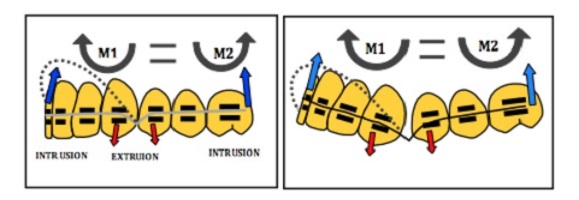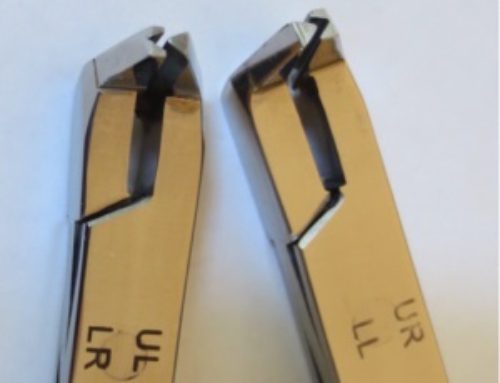The V-Bend technique is developed by combining the NiTi wire’s elasticity, and Bendistal pliers’ ability to bend those wires, and recruiting the V-Bend intrusive mechanics in both vertical and transverse planes.
The intrusion effects of V-Bend simplified disengaging the deep over bites, and correction of Class III malocclusions, while the step out and step in bends in the transverse plane had simplified the onerous cross-bite correction, with the same V-Bend intrusion and disengagement of posterior teeth (as shown in the illustration).
The intrusion effect of the V-Bend inserted by one squeeze of Bendistal pliers in NiTi archwires disengages locked out mandibular and maxillary anterior teeth without loops, helices and springs, and simplifies class III malocclusions correction without orthognathic surgery. This simple technique that combines the above mentioned available knowledge and new tools, such as Bendistal wire bending pliers, has made correction of such challenging orthodontic problem effective, convenient and clinically applicable (Learn about non-surgical Class III correction here).
Wondering what the V-bends technique is all about? In this blog, we’ll break down the V-bends technique into its fundamental stages, to help our readers understand how it helps in correcting class III malocclusions.
Stage#1: Alignment
As an initial step, both dental arches need to be aligned. For this purpose, most orthodontists use straight preformed 0.016” NiTi archwires. In case of class III malocclusions, the mandibular ones block maxillary incisors.
Stage#2: Intrusion and Disengagement
To correct this condition, both maxillary and mandibular incisors of teeth need to be disengaged to facilitate mandibular incisors retraction. Before this technique, only Orthognathic surgery was an eminent procedure for correction of this kind of malocclusions. With this technique this goal is achieved by inserting V-bends in super elastic wires to intrude and disengage those teeth.
Immediately after the alignment stage, mandibular incisor intrusion begins by placing intrusive V-bends behind mandibular canines. The intrusive forces applied by the bends act at the bracket site buccal and move the incisors in a clockwise anterior direction and molars in an anticlockwise posterior direction.
When the mandibular incisors have successfully intruded halfway, they can be bonded with the help of aligning archwire. To speed up anterior disengagement, orthodontists can also combine various intrusion mechanics on both archwires. In order to accelerate treatment, orthodontists can also opt for 0.016” x 0.022” NiTi wires which offer increased level of force on teeth.
Stage#3: Retraction
As soon as full disengagement takes place, retraction of teeth begins. In this stage, orthodontists create mandibular dental spaces with the help of interproximal enamel reduction or mandibular premolar extraction. Once the space has been created, a power chain is used with V-bends still in place to retract teeth. These bends help maintain the disengagement and prevent uncontrolled tipping.
Stage#4: Bite Jump of Incisors
When the incisors have retracted into the spaces created by the orthodontists, the final stage can commence. During this stage, orthodontists work to establish a normal overbite. To correct the final positions of roots, bend-less steel archwires are used.
In order to obtain the best results in treatment of patients with dental problems, orthodontists are always looking for opportunities to improve their practice. V-bends is an innovative non-surgical treatment technique capable of disengaging incisors, by using bite raising composite build-ups to intrude them. However, it involves the use of NiTi wires, which despite having remarkable elasticity, can’t be bent with conventional dental pliers.
That’s where Bendistal Pliers can help!
Our Bendistal and Omni pliers are capable of bending archwires at virtually every possible angle and can be used to apply the V-bends technique to treat class III malocclusions with ease.
Place an order or get in touch with us online!



Leave A Comment